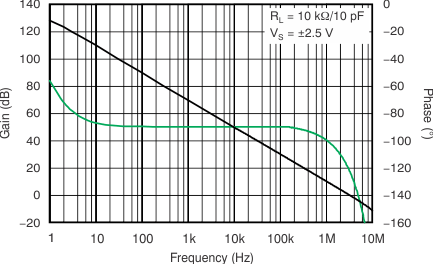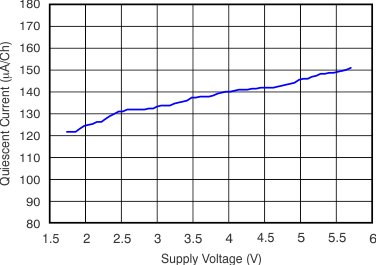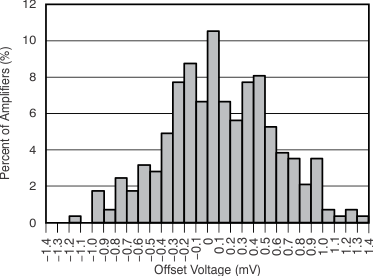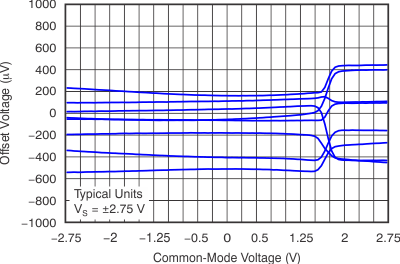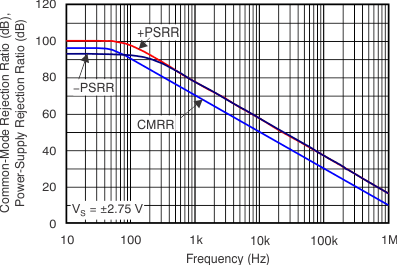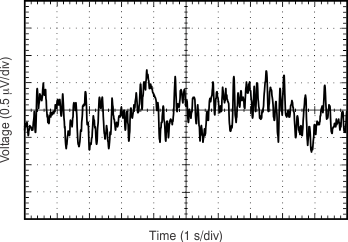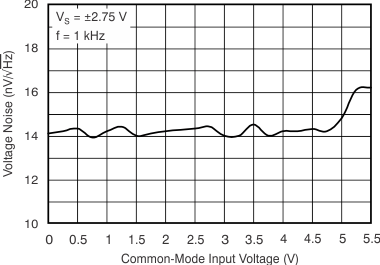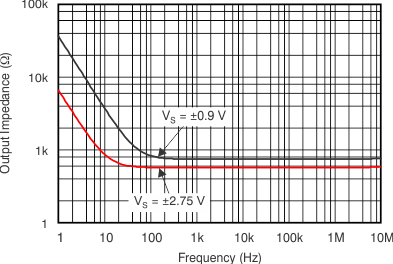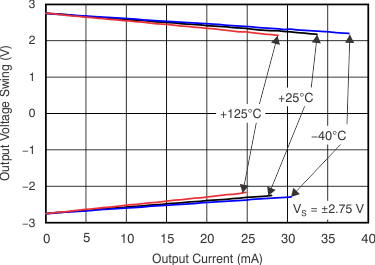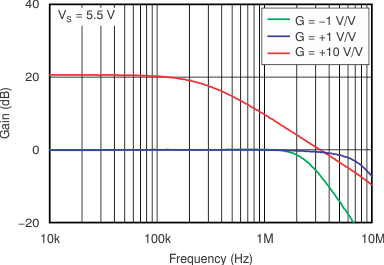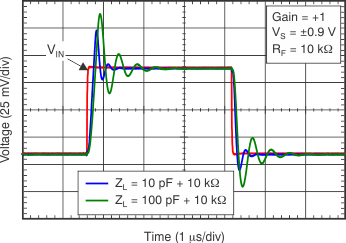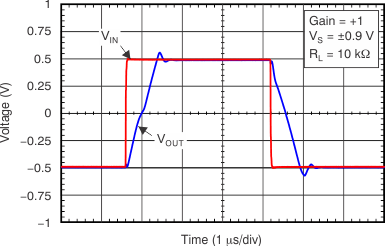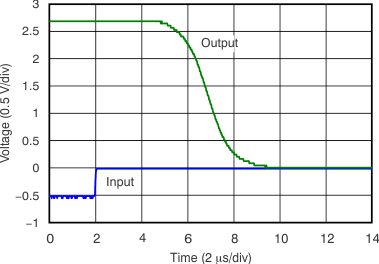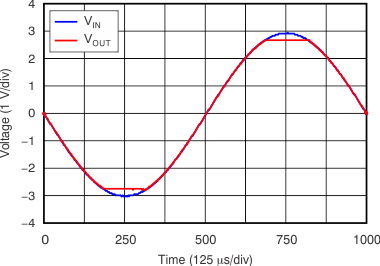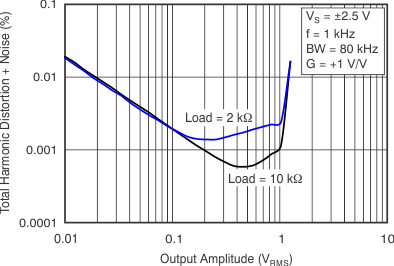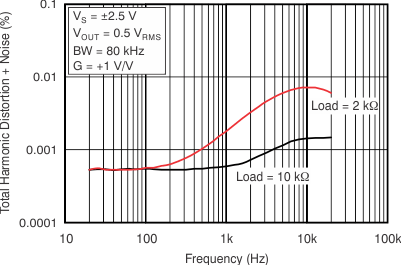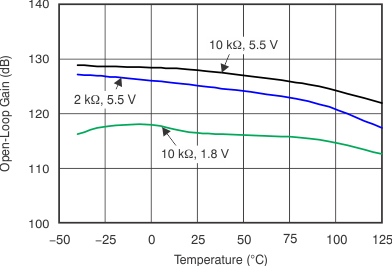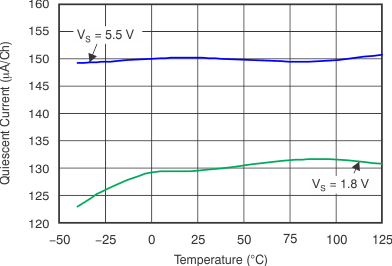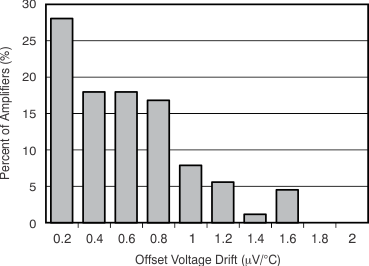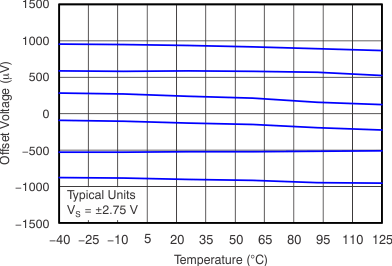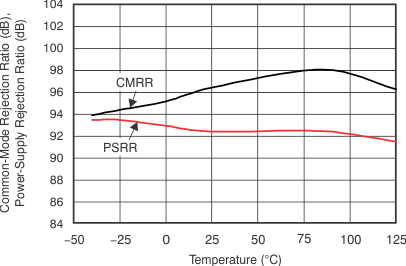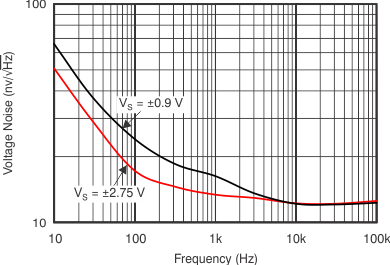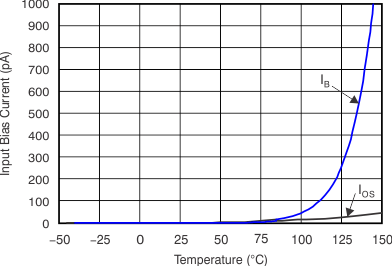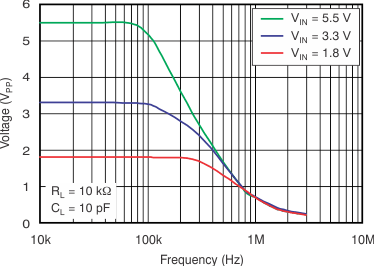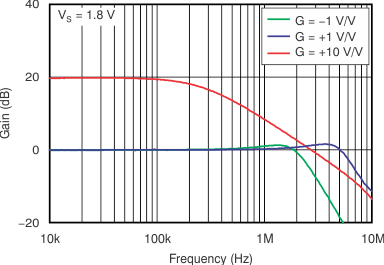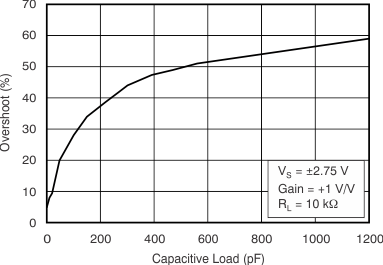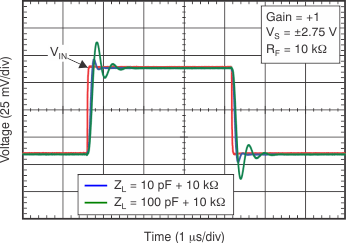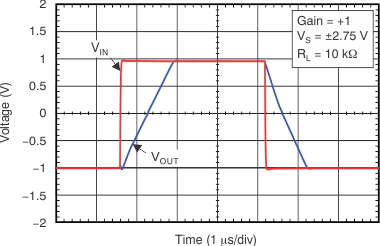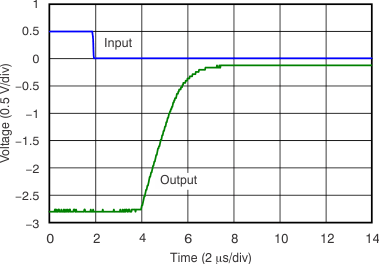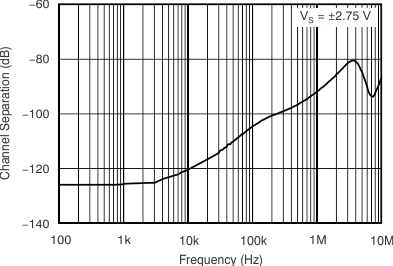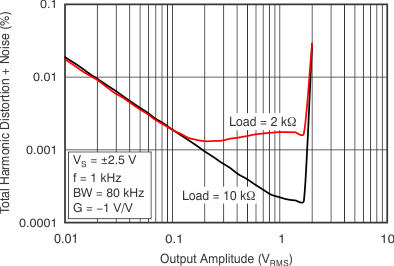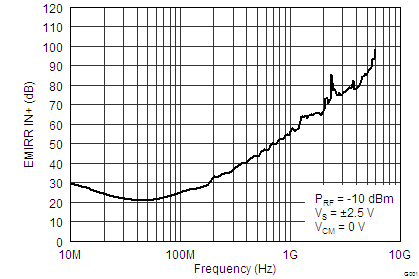SBOS563G May 2011 – June 2015 OPA2314 , OPA314 , OPA4314
PRODUCTION DATA.
- 1 Features
- 2 Applications
- 3 Description
- 4 Revision History
- 5 Pin Configuration and Functions
- 6 Specifications
- 7 Detailed Description
- 8 Application and Implementation
- 9 Power Supply Recommendations
- 10Layout
- 11Device and Documentation Support
- 12Mechanical, Packaging, and Orderable Information
パッケージ・オプション
メカニカル・データ(パッケージ|ピン)
- PW|14
サーマルパッド・メカニカル・データ
- PW|14
発注情報
6 Specifications
6.1 Absolute Maximum Ratings
Over operating free-air temperature range, unless otherwise noted.(1)| MIN | MAX | UNIT | ||
|---|---|---|---|---|
| Supply voltage | 7 | V | ||
| Signal input terminals | Voltage(2) | (V–) – 0.5 | (V+) + 0.5 | V |
| Current(2) | –10 | 10 | mA | |
| Output short-circuit(3) | Continuous | mA | ||
| Operating temperature, TA | –40 | 150 | °C | |
| Junction temperature, TJ | °C | |||
| Storage temperature, Tstg | –65 | 150 | °C | |
(1) Stresses above these ratings may cause permanent damage. Exposure to absolute maximum conditions for extended periods may degrade device reliability. These are stress ratings only, and functional operation of the device at these or any other conditions beyond those specified is not supported.
(2) Input terminals are diode-clamped to the power-supply rails. Input signals that can swing more than 0.5 V beyond the supply rails should be current limited to 10 mA or less.
(3) Short-circuit to ground, one amplifier per package.
6.2 ESD Ratings
| VALUE | UNIT | |||
|---|---|---|---|---|
| V(ESD) | Electrostatic discharge | Human-body model (HBM), per ANSI/ESDA/JEDEC JS-001(1) | ±4000 | V |
| Charged-device model (CDM), per JEDEC specification JESD22-C101(2) | ±1000 | |||
| Machine model (MM) | ±200 | |||
(1) JEDEC document JEP155 states that 500-V HBM allows safe manufacturing with a standard ESD control process.
(2) JEDEC document JEP157 states that 250-V CDM allows safe manufacturing with a standard ESD control process.
6.3 Recommended Operating Conditions
over operating free-air temperature range (unless otherwise noted)| MIN | NOM | MAX | UNIT | ||
|---|---|---|---|---|---|
| VS | Supply voltage | 1.8 (±0.9) | 5.5 (±2.75) | V | |
| TA | Ambient operating temperature | –40 | 125 | °C | |
6.4 Thermal Information: OPA314
| THERMAL METRIC(1) | OPA314 | UNIT | |||
|---|---|---|---|---|---|
| DBV (SOT23) | DCK (SC70) | DRL (SOT553) | |||
| 5 PINS | 5 PINS | 5 PINS | |||
| RθJA | Junction-to-ambient thermal resistance | 228.5 | 281.4 | 208.1 | °C/W |
| RθJC(top) | Junction-to-case(top) thermal resistance | 99.1 | 91.6 | 0.1 | °C/W |
| RθJB | Junction-to-board thermal resistance | 54.6 | 59.6 | 42.4 | °C/W |
| ψJT | Junction-to-top characterization parameter | 7.7 | 1.5 | 0.5 | °C/W |
| ψJB | Junction-to-board characterization parameter | 53.8 | 58.8 | 42.2 | °C/W |
(1) For more information about traditional and new thermal metrics, see the Semiconductor and IC Package Thermal Metrics application report, SPRA953.
6.5 Thermal Information: OPA2314
| THERMAL METRIC(1) | OPA2314 | UNIT | |||
|---|---|---|---|---|---|
| D (SO) | DGK (MSOP) | DRB (DFN) | |||
| 8 PINS | 8 PINS | 8 PINS | |||
| RθJA | Junction-to-ambient thermal resistance | 138.4 | 191.2 | 53.8 | °C/W |
| RθJC(top) | Junction-to-case(top) thermal resistance | 89.5 | 61.9 | 69.2 | °C/W |
| RθJB | Junction-to-board thermal resistance | 78.6 | 111.9 | 20.1 | °C/W |
| ψJT | Junction-to-top characterization parameter | 29.9 | 5.1 | 3.8 | °C/W |
| ψJB | Junction-to-board characterization parameter | 78.1 | 110.2 | 11.6 | °C/W |
(1) For more information about traditional and new thermal metrics, see the Semiconductor and IC Package Thermal Metrics application report, SPRA953.
6.6 Thermal Information: OPA4314
| THERMAL METRIC(1) | OPA4314 | UNIT | ||
|---|---|---|---|---|
| D (SOIC) | PW (TSSOP) | |||
| 14 PINS | 14 PINS | |||
| RθJA | Junction-to-ambient thermal resistance | 93.2 | 121 | °C/W |
| RθJC(top) | Junction-to-case(top) thermal resistance | 51.8 | 49.4 | °C/W |
| RθJB | Junction-to-board thermal resistance | 49.4 | 62.8 | °C/W |
| ψJT | Junction-to-top characterization parameter | 13.5 | 5.9 | °C/W |
| ψJB | Junction-to-board characterization parameter | 42.2 | 62.2 | °C/W |
(1) For more information about traditional and new thermal metrics, see the Semiconductor and IC Package Thermal Metrics application report, SPRA953.
6.7 Electrical Characteristics
VS = 1.8 V to 5.5 V; At TA = 25 °C, RL = 10 kΩ connected to VS/2, VCM = VS/2, and VOUT = VS/2, unless otherwise noted.(1)| PARAMETER | TEST CONDITIONS | TA = 25 °C | TA = –40°C to 125°C | UNIT | ||||||
|---|---|---|---|---|---|---|---|---|---|---|
| MIN | TYP | MAX | MIN | TYP | MAX | |||||
| OFFSET VOLTAGE | ||||||||||
| VOS | Input offset voltage | VCM = (VS+) – 1.3 V | 0.5 | 2.5 | mV | |||||
| dVOS/dT | vs Temperature | 1 | μV/°C | |||||||
| PSRR | vs power supply | VCM = (VS+) – 1.3 V | 78 | 92 | dB | |||||
| Over temperature | 74 | dB | ||||||||
| Channel separation, DC | At DC | 10 | µV/V | |||||||
| INPUT VOLTAGE RANGE | ||||||||||
| VCM | Common-mode voltage range | (V–) – 0.2 | (V+) + 0.2 | V | ||||||
| CMRR | Common-mode rejection ratio | VS = 1.8 V to 5.5 V, (VS–) – 0.2 V < VCM < (VS+) – 1.3 V | 75 | 96 | dB | |||||
| VS = 5.5 V, VCM = –0.2 V to 5.7 V(2) | 66 | 80 | dB | |||||||
| Over temperature | VS = 1.8 V, (VS–) – 0.2 V < VCM < (VS+) – 1.3 V | 70 | 86 | dB | ||||||
| VS = 5.5 V, (VS–) – 0.2 V < VCM < (VS+) – 1.3 V | 73 | 90 | dB | |||||||
| VS = 5.5 V, VCM = –0.2 V to 5.7 V(2) | 60 | dB | ||||||||
| INPUT BIAS CURRENT | ||||||||||
| IB | Input bias current | ±0.2 | ±10 | pA | ||||||
| Over temperature | ±600 | pA | ||||||||
| IOS | Input offset current | ±0.2 | ±10 | pA | ||||||
| Over temperature | ±600 | pA | ||||||||
| NOISE | ||||||||||
| Input voltage noise (peak-to-peak) | f = 0.1 Hz to 10 Hz | 5 | μVPP | |||||||
| en | Input voltage noise density | f = 10 kHz | 13 | nV/√Hz | ||||||
| f = 1 kHz | 14 | nV/√Hz | ||||||||
| in | Input current noise density | f = 1 kHz | 5 | fA/√Hz | ||||||
| INPUT CAPACITANCE | ||||||||||
| CIN | Differential | VS = 5 V | 1 | pF | ||||||
| Common-mode | VS = 5 V | 5 | pF | |||||||
| OPEN-LOOP GAIN | ||||||||||
| AOL | Open-loop voltage gain | VS = 1.8 V, 0.2 V < VO < (V+) – 0.2 V, RL = 10 kΩ | 90 | 115 | dB | |||||
| VS = 5.5 V, 0.2 V < VO < (V+) – 0.2 V, RL = 10 kΩ | 100 | 128 | dB | |||||||
| VS = 1.8 V, 0.5 V < VO < (V+) – 0.5 V, RL = 2 kΩ(2) | 90 | 100 | dB | |||||||
| VS = 5.5 V, 0.5 V < VO < (V+) – 0.5 V, RL = 2 kΩ(2) | 94 | 110 | dB | |||||||
| Over temperature | VS = 5.5 V, 0.2 V < VO < (V+) – 0.2 V, RL = 10 kΩ | 90 | 110 | dB | ||||||
| VS = 5.5 V, 0.5 V < VO < (V+) – 0.2 V, RL = 2 kΩ | 100 | dB | ||||||||
| Phase margin | VS = 5 V, G = 1, RL = 10 kΩ | 65 | ° | |||||||
| FREQUENCY RESPONSE | ||||||||||
| GBW | Gain-bandwidth product | VS = 1.8 V, RL = 10 kΩ, CL = 10 pF | 2.7 | MHz | ||||||
| VS = 5 V, RL = 10 kΩ, CL = 10 pF | 3 | MHz | ||||||||
| SR | Slew rate(3) | VS = 5 V, G = 1 | 1.5 | V/μs | ||||||
| tS | Settling time | To 0.1%, VS = 5 V, 2-V step , G = 1 | 2.3 | μs | ||||||
| To 0.01%, VS = 5 V, 2-V step , G = 1 | 3.1 | μs | ||||||||
| Overload recovery time | VS = 5 V, VIN × Gain > VS | 5.2 | μs | |||||||
| THD+N | Total harmonic distortion + noise(4) | VS = 5 V, VO = 1 VRMS, G = +1, f = 1 kHz, RL = 10 kΩ | 0.001% | |||||||
| OUTPUT | ||||||||||
| VO | Voltage output swing from supply rails | VS = 1.8 V, RL = 10 kΩ | 5 | 15 | mV | |||||
| VS = 5.5 V, RL = 10 kΩ | 5 | 20 | mV | |||||||
| VS = 1.8 V, RL = 2 kΩ | 15 | 30 | mV | |||||||
| VS = 5.5 V, RL = 2 kΩ | 22 | 40 | mV | |||||||
| Over temperature | VS = 5.5 V, RL = 10 kΩ | 30 | mV | |||||||
| VS = 5.5 V, RL = 2 kΩ | 60 | mV | ||||||||
| ISC | Short-circuit current | VS = 5 V | ±20 | mA | ||||||
| RO | Open-loop output impedance | VS = 5.5 V, f = 100 Hz | 570 | Ω | ||||||
| POWER SUPPLY | ||||||||||
| VS | Specified voltage range | 1.8 | 5.5 | V | ||||||
| IQ | Quiescent current per amplifier | OPA314, OPA2314, OPA4314, VS = 1.8 V, IO = 0 mA | 130 | 180 | µA | |||||
| OPA2314, OPA4314, VS = 5 V, IO = 0 mA | 150 | 190 | µA | |||||||
| OPA314, VS = 5 V, IO = 0 mA | 150 | 210 | µA | |||||||
| Over temperature | VS = 5 V, IO = 0 mA | 220 | µA | |||||||
| Power-on time | VS = 0 V to 5 V, to 90% IQ level | 44 | µs | |||||||
| TEMPERATURE | ||||||||||
| Specified range | –40 | 125 | °C | |||||||
| Operating range | –40 | 150 | °C | |||||||
| Storage range | –65 | 150 | °C | |||||||
(1) Parameters with minimum or maximum specification limits are 100% production tested at +25ºC, unless otherwise noted. Over temperature limits are based on characterization and statistical analysis.
(2) Specified by design and characterization; not production tested.
(3) Signifies the slower value of the positive or negative slew rate.
(4) Third-order filter; bandwidth = 80 kHz at –3 dB.
6.8 Typical Characteristics
Table 1. Characteristic Performance Measurements
| TITLE | FIGURE |
|---|---|
| Open-Loop Gain and Phase vs Frequency | Figure 1 |
| Open-Loop Gain vs Temperature | Figure 2 |
| Quiescent Current vs Supply Voltage | Figure 3 |
| Quiescent Current vs Temperature | Figure 4 |
| Offset Voltage Production Distribution | Figure 5 |
| Offset Voltage Drift Distribution | Figure 6 |
| Offset Voltage vs Common-Mode Voltage (Maximum Supply) | Figure 7 |
| Offset Voltage vs Temperature | Figure 8 |
| CMRR and PSRR vs Frequency (RTI) | Figure 9 |
| CMRR and PSRR vs Temperature | Figure 10 |
| 0.1-Hz to 10-Hz Input Voltage Noise (5.5 V) | Figure 11 |
| Input Voltage Noise Spectral Density vs Frequency (1.8 V, 5.5 V) | Figure 12 |
| Input Voltage Noise vs Common-Mode Voltage (5.5 V) | Figure 13 |
| Input Bias and Offset Current vs Temperature | Figure 14 |
| Open-Loop Output Impedance vs Frequency | Figure 15 |
| Maximum Output Voltage vs Frequency and Supply Voltage | Figure 16 |
| Output Voltage Swing vs Output Current (over Temperature) | Figure 17 |
| Closed-Loop Gain vs Frequency, G = 1, –1, 10 (1.8 V) | Figure 18 |
| Closed-Loop Gain vs Frequency, G = 1, –1, 10 (5.5 V) | Figure 19 |
| Small-Signal Overshoot vs Load Capacitance | Figure 20 |
| Small-Signal Step Response, Noninverting (1.8 V) | Figure 21 |
| Small-Signal Step Response, Noninverting ( 5.5 V) | Figure 22 |
| Large-Signal Step Response, Noninverting (1.8 V) | Figure 23 |
| Large-Signal Step Response, Noninverting ( 5.5 V) | Figure 24 |
| Positive Overload Recovery | Figure 25 |
| Negative Overload Recovery | Figure 26 |
| No Phase Reversal | Figure 27 |
| Channel Separation vs Frequency (Dual) | Figure 28 |
| THD+N vs Amplitude (G = 1, 2 kΩ, 10 kΩ) | Figure 29 |
| THD+N vs Amplitude (G = –1, 2 kΩ, 10 kΩ) | Figure 30 |
| THD+N vs Frequency (0.5 VRMS, G = +1, 2 kΩ, 10 kΩ) | Figure 31 |
| EMIRR | Figure 32 |
